CCNA 3 Chapter 10 Exam Answers
-
The graphic shows some partial output of the show ipv6 route command:
R2# show ipv6 route
OE2 ::/0 [110/1]
via FE80::200:CFF:FE3B:7501, GigabitEthernet0/0
O 2001:DB8:CAFE:1::/64 [110/2]
via FE80::200:CFF:FE3B:7501, GigabitEthernet0/0
C 2001:DB8:CAFE:2::/64 [0/0]
via GigabitEthernet0/1, directly connected
L 2001:DB8:CAFE:2::1/128 [0/0]
via GigabitEthernet0/1, receive
O 2001:DB8:CAFE:3::/64 [110/2]
via FE80::260:3EFF:FE02:EE01, GigabitEthernet0/0
OI 2001:DB8:CAFE:4::/64 [110/3]
via FE80::200:CFF:FE3B:7501, GigabitEthernet0/0
C 2001:DB8:CAFE:A001::/64 [0/0]
via GigabitEthernet0/0, directly connected
L 2001:DB8:CAFE:A001::2/128 [0/0]
via GigabitEthernet0/0, receive
OI 2001:DB8:CAFE:B001::/64 [110/2]
via FE80::200:CFF:FE3B:7501, GigabitEthernet0/0
Refer to the exhibit. What two conclusions can be drawn based on the output of the show ipv6 route command? (Choose two.)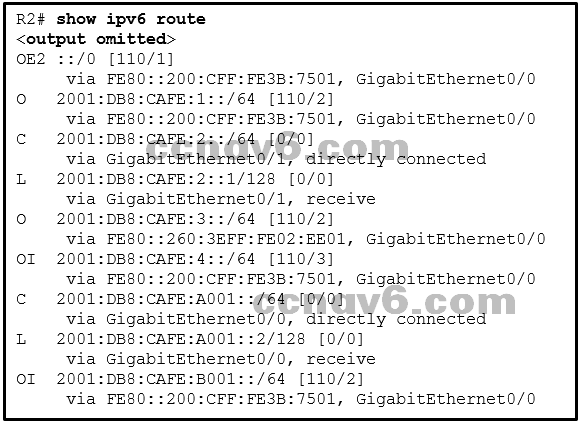
Route 2001:DB8:CAFE:4::/64 is an external route advertised by an ASBR.
R2 receives default route information from another router.*
Route 2001:DB8:CAFE:B001::/64 is a route advertised by an ABR.*
Routes 2001:DB8:CAFE:1::/64 and 2001:DB8:CAFE:3::/64 are advertised from the same router.
Route 2001:DB8:CAFE:4::/64 is advertised by a router three hops away. -
Refer to the exhibit. What three conclusions can be drawn from the displayed output? (Choose three.)
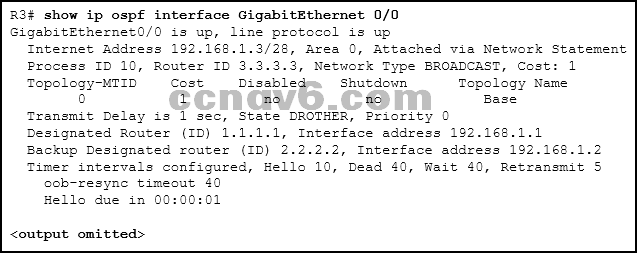
The DR can be reached through the GigabitEthernet 0/0 interface.*
There have been 9 seconds since the last hello packet sent.*
This interface is using the default priority.
The router ID values were not the criteria used to select the DR and the BDR.*
The router ID on the DR router is 3.3.3.3
The BDR has three neighbors. -
A network engineer has manually configured the hello interval to 15 seconds on an interface of a router that is running OSPFv2. By default, how will the dead interval on the interface be affected?
The dead interval will now be 60 seconds.*
The dead interval will now be 30 seconds.
The dead interval will not change from the default value.
The dead interval will now be 15 seconds. -
Refer to the exhibit. What are three resulting DR and BDR elections for the given topology? (Choose three.)
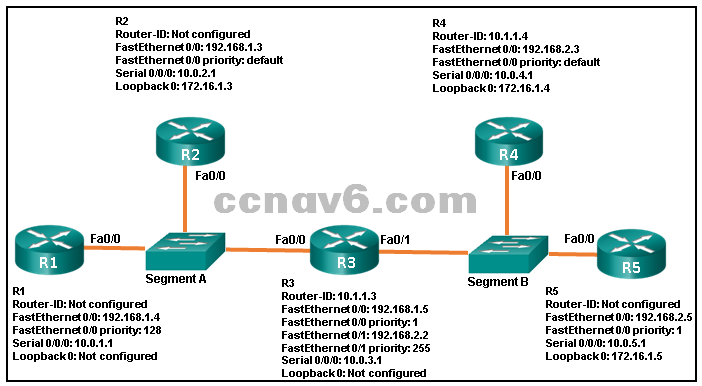
R4 is BDR for segment B.
R1 is DR for segment A.*
R2 is BDR for segment A.*
R3 is DR for segment A.
R5 is BDR for segment B.*
R3 is BDR for segment A. -
Which two parameters must match between neighboring OSPF routers in order to form an adjacency? (Choose two.)
router ID
IP address
process ID
cost
hello / dead timers*
network types* -
Which command can be used to view the OSPF hello and dead time intervals?
show ip protocols
show ip ospf interface*
show ip ospf neighbor
show ip ospf route -
A network administrator is troubleshooting an OSPFv3 configuration on an IPv6 network. The administrator issues the show ipv6 protocols command. What is the purpose for this command?
to verify that the router has formed an adjacency with its neighboring routers
to display the OSPFv3 parameters configured on an interface
to display the OSPFv3 learned routes in the routing table
to verify OSPFv3 configuration information* -
A network administrator has just changed the router ID on a router that is working in an OSPFv2 environment. What should the administrator do to reset the adjacencies and use the new router ID?
Issue the clear ip ospf process privileged mode command.*
Configure the network statements.
Change the interface priority.
Change the OSPFv2 process ID. -
Refer to the exhibit. What the amount of time that has elapsed since the router received a hello packet?
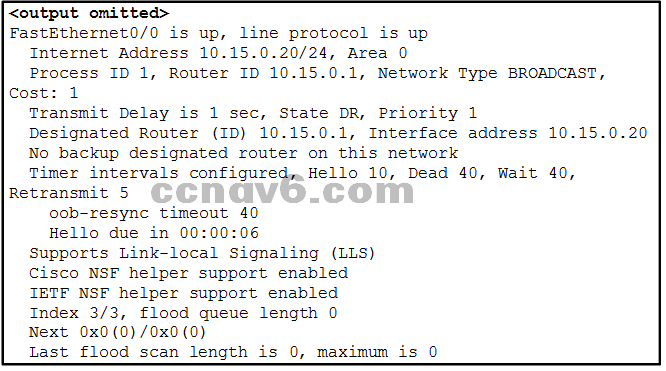
40 seconds
4 seconds*
10 seconds
6 seconds -
Open the PT Activity. Perform the tasks in the activity instructions and then answer the question.
A network administrator is configuring multiarea OSPFv3 on the routers. The routing design requires that the router RT1 is a DROTHER for the network in Area 0 and the DR for the network in Area 1. Check the settings and status of the routers. What can the administrator do to ensure that RT1 will meet the design requirement after all routers restart?Use the ipv6 ospf priority 0 command on the interface g0/0 of RT1.
Use the ipv6 ospf priority 10 command on the interface g0/2 of RT1.*
Configure the loopback 0 interface with 6.6.6.6.
Restart all routers except for RT1.
Change the router ID to 5.5.5.5 on RT1. -
Refer to the exhibit. A network administrator is configuring OSPF for R1 and R2, but the adjacency cannot be established. What is the cause of the issue?
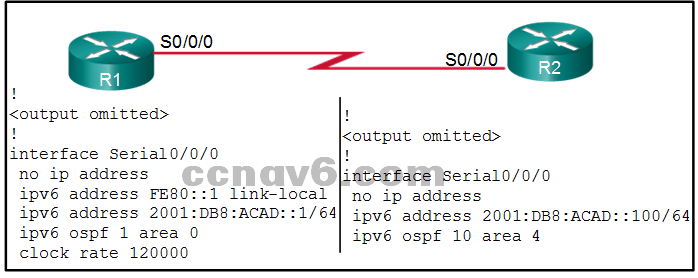
The interface s0/0/0 on router R2 is missing a link-local address.
The process ID is misconfigured.
The IP address on router R2 is misconfigured.
The area ID is misconfigured.* -
Refer to the exhibit. A network administrator has configured OSPFv2 on the two Cisco routers but PC1 is unable to connect to PC2. What is the most likely problem?
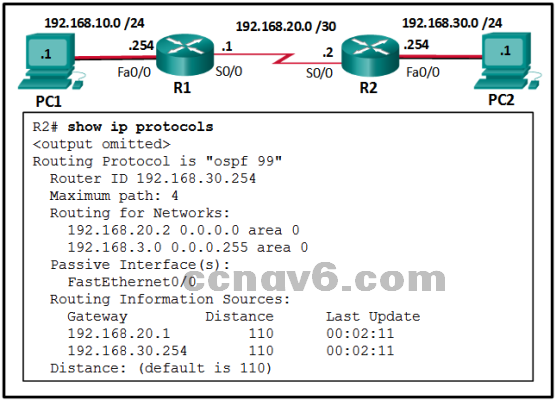
Interface Fa0/0 is configured as a passive-interface on router R2.
Interface S0/0 is configured as a passive-interface on router R2.
Interface Fa0/0 has not been activated for OSPFv2 on router R2.*
Interface s0/0 has not been activated for OSPFv2 on router R2. -
What three states are transient OPSF neighbor states that indicate a stable adjacency is not yet formed between two routers? (Choose three.)
established
loading*
2way
exstart*
full
exchange* -
An administrator is troubleshooting OSPFv3 adjacency issues. Which command would the administrator use to confirm that OSPFv3 hello and dead intervals are matching between routers?
show ipv6 ospf interface*
show ipv6 ospf
show ipv6 ospf neighbor
show ipv6 protocols -
When checking a routing table, a network technician notices the following entry:
O*E2 0.0.0.0/0 [110/1] via 192.168.16.3, 00:20:22, Serial0/0/0
What information can be gathered from this output?The route is located two hops away.
The metric for this route is 110.
The edge of the OSPF area 0 is the interface that is addressed 192.168.16.3.
This route is a propagated default route.* -
Refer to the exhibit. R1 and R2 are connected to the same LAN segment and are configured to run OSPFv3. They are not forming a neighbor adjacency. What is the cause of the problem?

The IPv6 addresses of R1 and R2 are not in the same subnet.
The priority value of both R1 and R2 is 1.
The timer intervals of R1 and R2 do not match.*
The OSPFv3 process IDs of R1 and R2 are different. -
Refer to the exhibit. Directly connected networks configured on router R1 are not being shared with neighboring routers through OSPFv3. What is the cause of the issue?
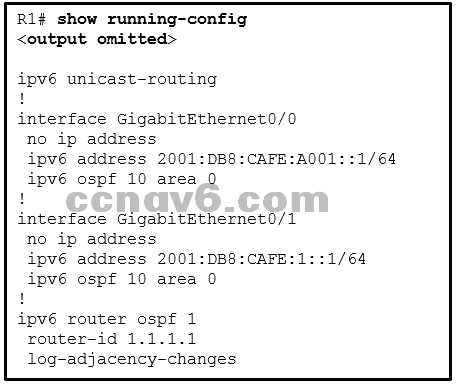
There are no network statements for the routes in the OSPF configuration.
The no shutdown command is missing on the interfaces.
IPv6 OSPF routing is not enabled.
There is a mismatch of OSPF process ID in commands.* -
Open the PT Activity. Perform the tasks in the activity instructions and then answer the question.
Which routers are the DR and BDR in this topology?DR:R6 BDR:R5
DR:R1 BDR:R2
DR:R5 BDR:R3
DR:R3 BDR:R6
DR:R3 BDR:R5*
DR:R4 BDR:R1 -
Refer to the exhibit. Which conclusion can be drawn from this OSPF multiaccess network?
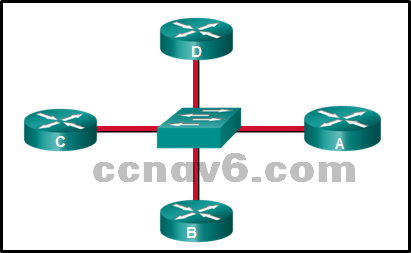
If the DR stops producing Hello packets, a BDR will be elected, and then it promotes itself to assume the role of DR.
With an election of the DR, the number of adjacencies is reduced from 6 to 3.*
When a DR is elected all other non-DR routers become DROTHER.
All DROTHER routers will send LSAs to the DR and BDR to multicast 224.0.0.5. -
Which command will a network engineer issue to verify the configured hello and dead timer intervals on a point-to-point WAN link between two routers that are running OSPFv2?
show ipv6 ospf interface serial 0/0/0
show ip ospf neighbor
show ip ospf interface fastethernet 0/1
show ip ospf interface serial 0/0/0* -
Question as presented:
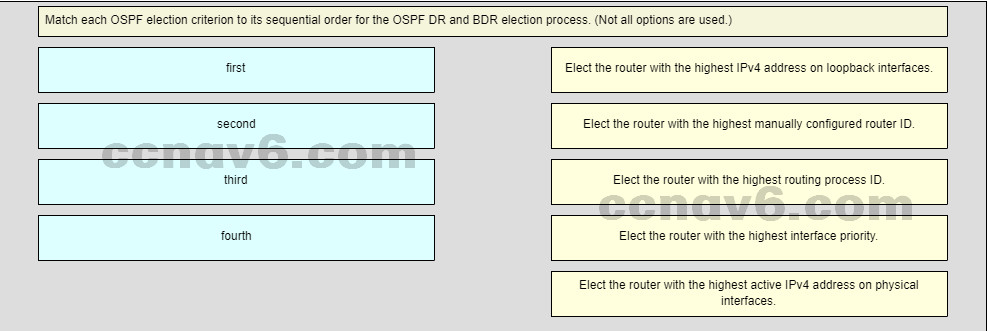
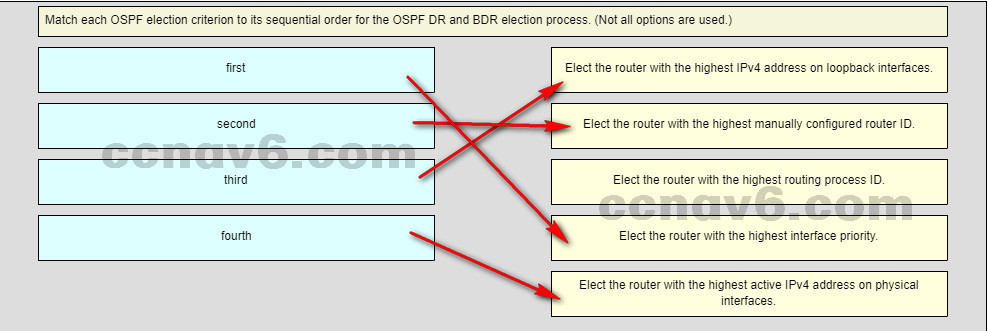
-
Which OSPF feature allows a remote OSPF area to participate in OSPF routing when it cannot connect directly to OSPF Area 0?
virtual link*
NBMA
point-to-point connectivity
DR/BDR -
A network engineer suspects that OSPFv3 routers are not forming neighbor adjacencies because there are interface timer mismatches. Which two commands can be issued on the interface of each OSFPv3 router to resolve all timer mismatches? (Choose two.)
no ipv6 ospf dead-interval*
ip ospf hello-interval 10
no ipv6 router ospf 10
no ipv6 ospf cost 10
no ipv6 ospf hello-interval*
ip ospf dead-interval 40
